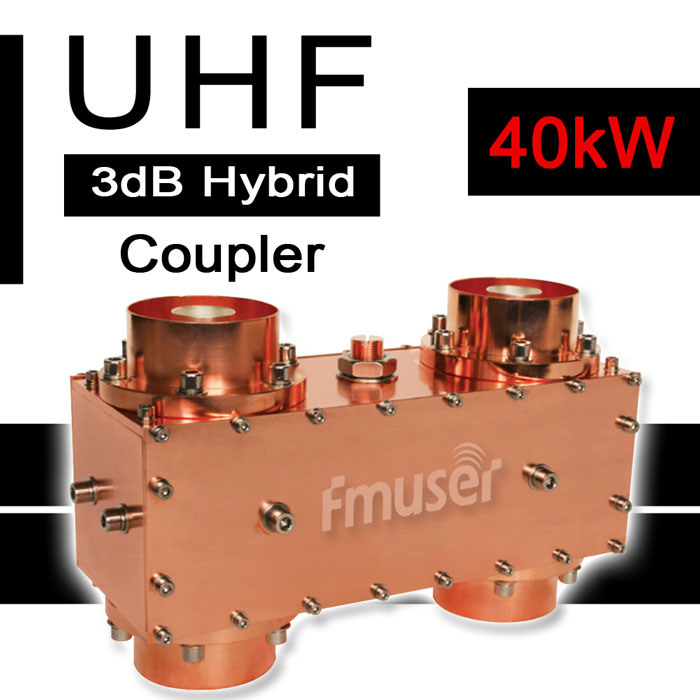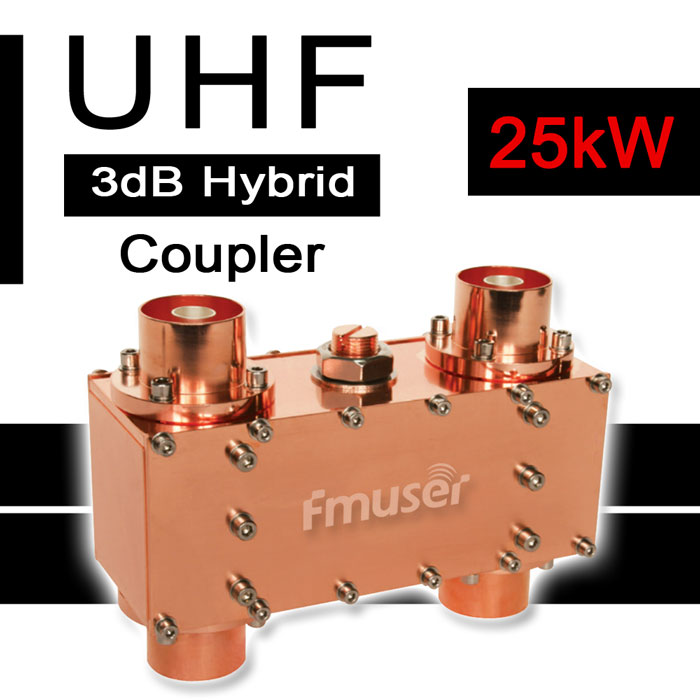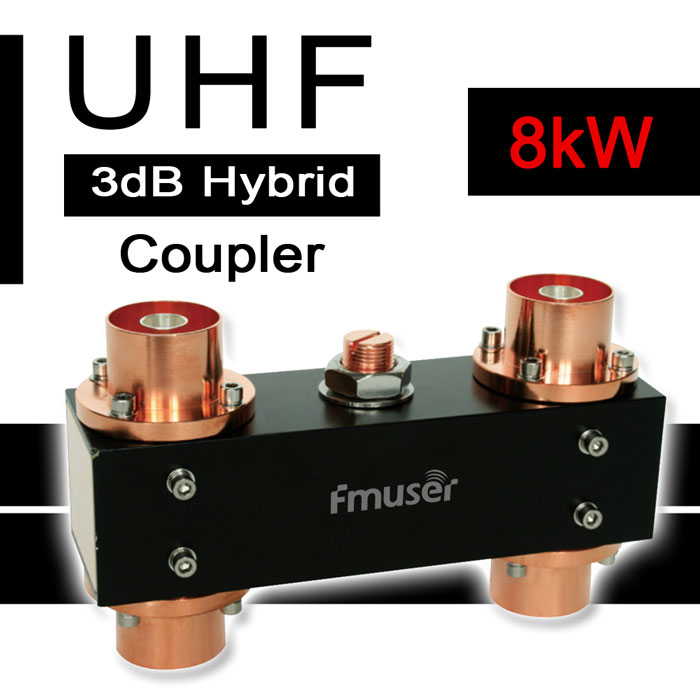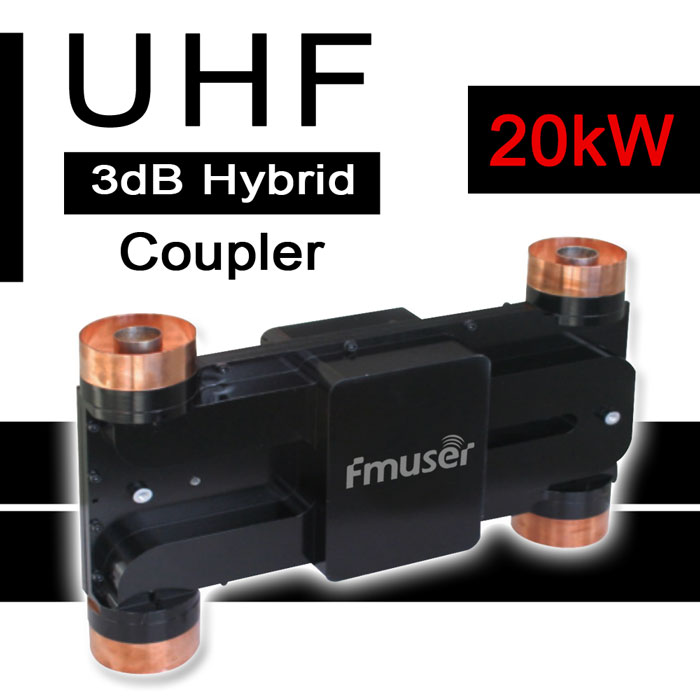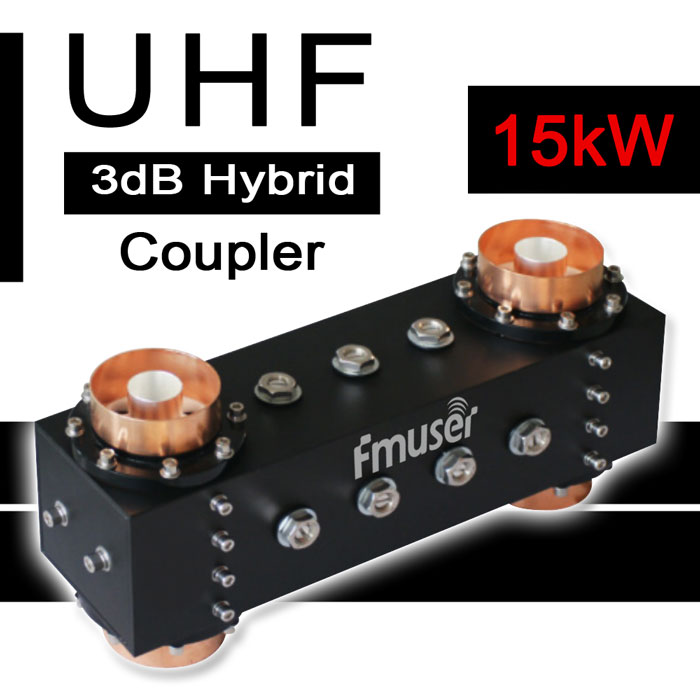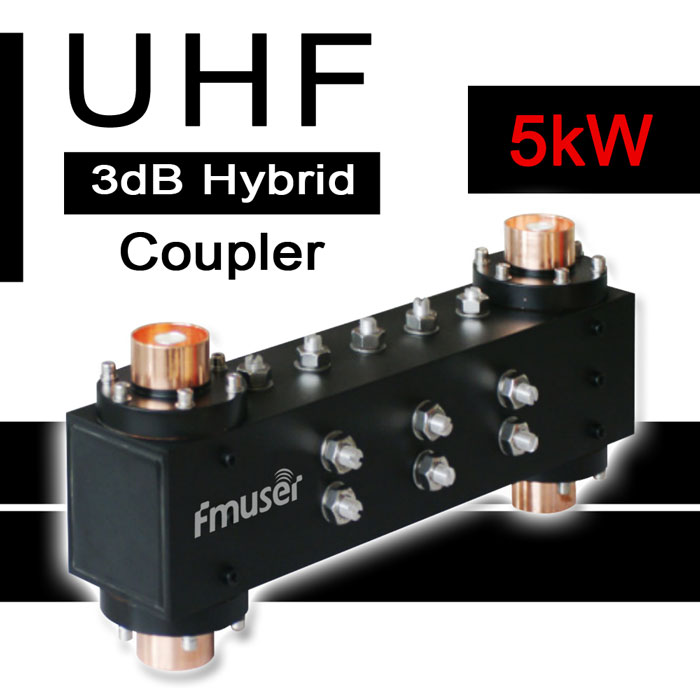
UHF Couplers
Coupler ibridu UHF huwa tip ta 'splitter tas-sinjal li jintuża l-aktar spiss għal applikazzjonijiet ta' frekwenza tar-radju (RF). Għandu erba 'portijiet, li tnejn minnhom għandhom sinjal ta' input u t-tnejn l-oħra għandhom sinjal ta 'ħruġ. L-aktar applikazzjonijiet komuni ta 'koppjar ibridu UHF huma li jaqsam sinjal f'żewġ mogħdijiet differenti, jgħaqqad żewġ sinjali f'sinjal wieħed, jew tittrasferixxi l-enerġija minn port għal ieħor. Tista 'tintuża wkoll biex tqabbel impedenza differenti taż-żewġ sinjali li qed jiġu kkombinati jew maqsuma.
-
![470-862 MHz 40kW 4 1/2" UHF Stripline 3dB Hybrid Coupler High Power RF Coupler Compact RF Divider Combiner for TV Broadcasting]()
Prezz (USD): Itlob għal kwotazzjoni
Mibjugħa: 34
-
![470-862 MHz 25kW 3 1/8" UHF Stripline 3dB Hybrid Coupler TX RX RF Power Coupler High Power RF Splitter Combiner for TV Station]()
Prezz (USD): Itlob għal kwotazzjoni
Mibjugħa: 34
-
![470-862 MHz 8kW 1 5/8" UHF 3dB Hybrid Coupler High Power RF Splitter 4 Port RF Divider Combiner UHF Power Divider for TV Station]()
Prezz (USD): Itlob għal kwotazzjoni
Mibjugħa: 34
-
![470-862 MHz 20kW 1 5/8" 3db Hybrid Coupler Stripline RF Splitter TX UHF Hybrid Power Combiner UHF Power Divider for TV Station]()
Prezz (USD): Itlob għal kwotazzjoni
Mibjugħa: 34
-
![470-862 MHz 15kW 1 5/8" 3dB UHF Wideband Coupler Compact 3db Hybrid Coupler TX Stripline Hybrid Splitter Combiner for TV Station]()
Prezz (USD): Itlob għal kwotazzjoni
Mibjugħa: 34
-
![470-862 MHz 5kW 1 5/8" 3dB UHF Broadband Coupler Wideband Hybrid Coupler High Power Stripline Power Divider for FM Broadcasting]()
Prezz (USD): Itlob għal kwotazzjoni
Mibjugħa: 34
- X'inhu coupler ibridu UHF, u x'inhu s-sinonimu tiegħu?
- Coupler ibridu UHF huwa apparat użat f'sistemi ta 'frekwenza tar-radju biex jgħaqqad jew jaqsam sinjali. Huwa magħruf ukoll bħala tee ibridu, coupler quadrature, jew Hy-Tee.
- Kif tuża coupler ibridu UHF għax-xandir?
- Passi biex tuża b'mod korrett coupler ibridu UHF fl-istazzjon tax-xandir:
1. Qabbad il-port tad-dħul tal-coupler mat-trasmettitur.
2. Qabbad il-port tal-ħruġ tal-coupler mas-sistema tal-antenna.
3. Qabbad il-port tal-monitor tal-coupler ma 'analizzatur tal-ispettru jew apparat ieħor ta' monitoraġġ.
4. Intuna l-coupler għall-frekwenza mixtieqa.
5. Aġġusta l-qawwa tal-ħruġ tal-coupler għal-livell mixtieq.
6. Immonitorja l-qawwa tal-ħruġ u agħmel l-aġġustamenti meħtieġa.
7. Tissorvelja s-sistema għal kwalunkwe interferenza u tindirizza kwalunkwe kwistjoni li tqum.
Problemi li għandhom jiġu evitati:
1. Nuqqas ta 'qbil fl-antenna li jista' jikkawża telf jew distorsjoni tas-sinjal.
2. Qawwa insuffiċjenti li tista 'tikkawża tnaqqis tas-sinjali.
3. Qawwa eċċessiva li tista 'tikkawża interferenza għal servizzi oħra.
4. Monitoraġġ fqir li jista 'jikkawża kwistjonijiet ta' kwalità tas-sinjal.
5. Manutenzjoni fqira tas-sistema li tista 'tikkawża kwistjonijiet fit-tul.
- Kif jaħdem coupler ibridu UHF?
- Coupler ibridu UHF huwa apparat li jintuża fl-istazzjonijiet tax-xandir biex jgħaqqad u jaqsam is-sinjali. Taħdem billi tgħaqqad is-sinjali tal-input mit-trasmettitur fuq l-istess linja ta 'trażmissjoni, filwaqt li tipprovdi wkoll passaġġ bejn it-trasmettitur u l-antenna. Dan jippermetti lill-istazzjon tax-xandir jittrasmetti sinjal wieħed mingħajr interferenza, filwaqt li xorta jkun jista 'jirċievi sinjali minn sorsi oħra. Il-coupler ibridu jiżgura wkoll li t-trasmettitur ma jinterferixxix ma 'sinjali oħra li huma preżenti fuq il-linja.
- Għaliex huwa importanti coupler ibridu UHF għal stazzjon tar-radju?
- Coupler ibridu UHF huwa importanti għall-istazzjonijiet tax-xandir għaliex jippermettilhom jaqsmu s-sinjali tagħhom f'żewġ antenni separati, li jippermetti kopertura akbar tas-sinjali. Dan huwa speċjalment importanti għal stazzjonijiet bi trasmettituri multipli f'postijiet differenti. Billi juża coupler ibridu UHF, ix-xandara jistgħu jiżguraw li s-sinjal tagħhom jilħaq kemm jista 'jkun mingħajr interferenza jew distorsjoni. Għalhekk, iva, coupler ibridu UHF huwa meħtieġ għal stazzjon tax-xandir.
- Kemm hemm tipi ta' couplers ibridi UHF u x'inhuma d-differenzi bejniethom?
- Hemm tliet tipi ta ' couplers ibridi UHF: couplers 180 grad, couplers 90 grad, u couplers quadrature. Id-differenza ewlenija bejniethom hija l-grad tal-phase shift, li huwa 180 grad għall-coupler ta '180 grad, 90 grad għall-coupler ta' 90 grad, u 45 grad għall-coupler quadrature. Barra minn hekk, il-coupler ta '180 grad jintuża għall-qsim u l-kombinazzjoni tas-sinjali, filwaqt li l-couplers ta' 90 grad u quadrature jintużaw prinċipalment biex jgħaqqdu u jaqsmu sinjali.
- Kif tagħżel l-aħjar coupler ibridu UHF?
- Qabel ma titqiegħed ordni finali, huwa importanti li jitqabblu couplers ibridi UHF differenti bbażati fuq l-ispeċifikazzjonijiet tagħhom, bħal telf ta 'inserzjoni, firxa ta' frekwenza, iżolament, telf ta 'ritorn, kapaċità ta' mmaniġġjar ta 'enerġija, u daqs. Barra minn hekk, huwa importanti li ssir riċerka dwar il-manifattur biex jiġi żgurat li għandhom reputazzjoni tajba u li huma magħrufa għall-produzzjoni ta 'prodotti affidabbli.
- Kif tikkonnettja b'mod korrett coupler ibridu UHF fis-sistema tax-xandir?
- Biex tikkonnettja b'mod korrett coupler ibridu UHF fi stazzjon tax-xandir, għandhom jiġu segwiti l-passi li ġejjin:
1. Qabbad il-port tad-dħul tal-coupler ibridu mal-port tal-ħruġ tat-trasmettitur.
2. Qabbad il-port tal-ħruġ tal-coupler ibridu mal-antenna.
3. Qabbad iż-żewġ portijiet li fadal (A u B) maż-żewġ linji tal-antenna. Kun żgur li l-impedenza taż-żewġ linji hija mqabbla b'mod korrett.
4. Iċċekkja l-konnessjonijiet kollha u kun żgur li l-coupler ibridu qed jaħdem sew.
5. Inqabbad is-swiċċ tal-bypass tal-coupler ibridu biex tlesti l-konnessjoni.
- X'tagħmir huwa relatat ma' coupler ibridu UHF?
- It-tagħmir relatat ma 'coupler ibridu UHF fi stazzjon tax-xandir jinkludi combiner RF, couplers direzzjonali, swiċċijiet RF, diviżuri tal-enerġija, u amplifikaturi ta' storbju baxx. Barra minn hekk, jistgħu jintużaw ukoll unitajiet tal-irfinar tal-antenna, amplifikaturi tal-gwadann tal-antenna u swiċċijiet tal-antenna.
- X'inhuma l-aktar speċifikazzjonijiet fiżiċi u RF importanti ta' coupler ibridu UHF?
- L-aktar speċifikazzjonijiet fiżiċi u RF importanti ta 'koppjar ibridu UHF huma telf ta' inserzjoni, direttività, iżolament, telf ta 'ritorn, firxa ta' frekwenza, firxa ta 'temperatura, immaniġġjar tal-enerġija, VSWR, u impedenza.
- Kif iżżomm korrettament coupler ibridu UHF bħala inġinier?
- Biex twettaq sew il-manutenzjoni ta 'kuljum fuq coupler ibridu UHF fi stazzjon tax-xandir, inġinier għandu jagħmel dan li ġej:
1. Iċċekkja l-konnessjonijiet kollha biex tiżgura li huma siguri u bil-fili kif suppost.
2. Ittestja l-livelli tas-sinjali biex tiżgura li huma fi ħdan l-ispeċifikazzjonijiet tal-manifattur.
3. Monitora t-temperatura tal-coupler biex tiżgura li tkun fl-aħjar temperatura operattiva.
4. Iċċekkja għal kwalunkwe sinjali ta 'xedd jew ħsara li setgħu seħħew maż-żmien.
5. Naddaf il-coupler b'ċarruta ratba biex tneħħi kwalunkwe trab jew debris.
6. Ittestja l-coupler billi tibgħat sinjali predeterminati permezz tiegħu biex tiżgura tħaddim tajjeb.
7. Agħmel kwalunkwe aġġustamenti meħtieġa biex tiżgura li l-coupler qed jaħdem sew.
Wara dawn il-passi għandu jiżgura li l-coupler ibridu UHF tiegħek ikun f'kundizzjoni tajba ta' ħidma u lest biex iwettaq il-kompiti magħżula tiegħu.
- Kif isewwi coupler ibridu UHF jekk ma jkunx qed jaħdem?
- Biex isewwi coupler ibridu UHF, l-ewwel għandek tidentifika l-partijiet miksura. Ladarba tkun identifikajt il-partijiet li mhumiex qed jaħdmu, imbagħad għandek tissostitwihom b'partijiet ġodda. Skont it-tip ta 'coupler ibridu li għandek, jista' jkollok bżonn tixtri partijiet speċifiċi għalih, bħal konnetturi, kejbils jew komponenti oħra.
Ladarba jkollok il-partijiet meħtieġa, għandek imbagħad issegwi l-istruzzjonijiet li ġew mal-coupler, jew tikkonsulta professjonist għall-għajnuna. Skont il-kumplessità tal-apparat, jista 'jkollok bżonn issaldja l-partijiet il-ġodda f'postha jew tuża qfieli mekkaniċi. Ladarba l-partijiet jiġu installati, imbagħad għandek tixgħel il-coupler u tittestjah biex tiżgura li qed taħdem b'mod korrett.
- Kif tagħżel l-ippakkjar it-tajjeb għal coupler ibridu UHF?
- Meta tagħżel l-ippakkjar it-tajjeb għal coupler ibridu UHF, huwa importanti li jiġi żgurat li l-ippakkjar ikun iddisinjat biex jipproteġi l-apparat minn kwalunkwe ħsara waqt it-trasport. Għandu wkoll ikun kapaċi jipproteġi l-apparat minn kwalunkwe tibdil ambjentali bħal temperatura, umdità u vibrazzjoni. Oqgħod attent għall-materjali tal-ippakkjar u l-metodu tas-siġillar biex tiżgura li l-apparat ikun ippakkjat sew u mhux se jiġi affettwat minn forzi esterni. Barra minn hekk, agħti attenzjoni għall-metodu tat-tbaħħir u kun żgur li huwa adattat għall-apparat.
- Liema materjal jintuża għall-kisi ta 'coupler ibridu UHF?
- Il-kisi ta 'coupler ibridu UHF huwa ġeneralment magħmul minn metall, bħall-aluminju jew l-istainless steel. Dawn il-materjali mhux se jaffettwaw il-prestazzjoni tiegħu, sakemm ikun iżolat sew.
- X'inhi l-istruttura bażika ta 'coupler ibridu UHF?
- Coupler ibridu UHF (Ultra-High Frequency) huwa magħmul minn żewġ netwerks b'erba' portijiet konnessi flimkien. L-erba 'portijiet huma l-portijiet ta' input, output, somma u differenza. Il-port tad-dħul jirċievi s-sinjal, il-port tal-ħruġ jibgħat is-sinjal, il-port tas-somma jgħaqqad iż-żewġ sinjali flimkien, u l-port tad-differenza jnaqqas iż-żewġ sinjali minn xulxin. L-istruttura tal-coupler ibridu tiddetermina l-prestazzjoni u l-attributi tal-coupler. L-erba 'portijiet, il-linji ta' trasmissjoni u l-junctions tal-linji ta 'trażmissjoni jiffurmaw l-istruttura bażika tal-coupler ibridu. Mingħajr l-ebda waħda minn dawn l-istrutturi, il-coupler ma jkunx jista' jaħdem b'mod normali.
- Min għandu jiġi assenjat biex iħaddem coupler ibridu UHF?
- Il-persuna li għandha tiġi assenjata biex tmexxi coupler ibridu UHF fi stazzjon tax-xandir idealment għandha jkollha ħiliet u esperjenza qawwija tekniċi u elettroniċi. Għandhom ukoll ikollhom fehim sod tal-prinċipji tat-trażmissjoni tax-xandir bir-radju u l-abbiltà li jsolvu xi problemi li jistgħu jinqalgħu. Barra minn hekk, għandu jkollhom ħiliet eċċellenti ta’ komunikazzjoni u soluzzjoni tal-problemi.
IKKUNTATJANA


GRUPP INTERNAZZJONALI FMUSER LIMITED.
Aħna dejjem nipprovdu lill-klijenti tagħna prodotti affidabbli u servizzi meqjusa.
Jekk tixtieq iżżomm kuntatt magħna direttament, jekk jogħġbok mur fuq Ikkuntatjana
